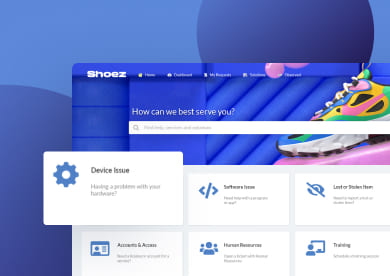Proactive IT Asset Management (or proactive ITAM) is one of the smartest ways to get the most value out of your IT assets. Instead of reacting to issues after they appear, this approach helps you anticipate problems and, in the best-case scenario, avoid them altogether.
In this article, we’ll break down what proactive IT Asset Management really means, why it’s essential for modern organizations, and 10 practical ways to implement it so you can start seeing results fast.
What is proactive IT Asset Management?
Proactive IT Asset Management is the practice of anticipating and addressing potential issues with your IT assets before they cause disruptions.
This can mean anything from foreseeing a shortage of laptops for new hires, to detecting potential configuration problems, spotting software nearing license expiration, or identifying hardware that’s about to reach end-of-life.
How does proactive IT Asset Management work?
A proactive ITAM approach starts by fully understanding your organization’s IT Asset Management requirements and anticipating the IT services employees will need. From there, it ensures the company has the right assets available at the right time (and at the lowest possible cost).
It all begins with building a detailed IT inventory that tracks every software license, hardware device, and even non-IT asset in real time. With that foundation, you gain visibility into which assets are assigned or available, whether they’re meeting business needs, and when investments or replacements may be required.
Why is proactively managing IT assets in the workplace important?
Proactively managing IT assets helps organizations stay in control. By anticipating needs and addressing risks early, IT teams can reduce downtime, optimize costs, and make sure every device, license, and system supports the business effectively.
In short, proactive IT Asset Management turns IT from reactive problem-solving into strategic planning.
5 key benefits of proactive IT Asset Management
- Fewer disruptions – Detect potential failures or shortages early to keep employees and operations running smoothly.
- Lower costs – Avoid unnecessary purchases, license penalties, and emergency fixes by planning ahead.
- Better compliance – Stay on top of software licenses, warranties, and security standards to prevent violations.
- Smarter decision-making – Use accurate, real-time asset data to plan budgets, replacements, and upgrades with confidence.
- Longer asset lifespan – Maintain and update assets proactively to extend their useful life and maximize return on investment.

10 ways to do proactive IT Asset Management
#1: Build an IT Asset Management team
A dedicated IT Asset Management team is essential for effective and proactive IT Asset Management. Why? Because ITAM is complex — and it’s only getting more challenging as organizations rely on an ever-growing number of IT assets.
Every asset needs to be properly tracked, maintained, and secured. When ITAM fails, the consequences can be costly: from compliance fines and licensing penalties to increased exposure to cybersecurity risks.
That’s why having skilled IT asset managers and a dedicated ITAM team is key. They ensure your organization stays ahead of potential issues, keeps assets optimized, and maintains full visibility and control over the IT environment.
#2: Use a dedicated proactive IT Asset Management software
Spreadsheets might work for small inventories, but they quickly become unreliable and time-consuming as your organization grows. An IT Asset Management software automates the heavy lifting.
Acquiring an ITAM tool is a smart idea because it continuously monitors your hardware and software assets, provides visibility into their status, and delivers insights to optimize costs, maintenance, and lifecycle planning. In short, it replaces guesswork with actionable data so your IT team can focus on strategy, not spreadsheets.
#3: Use automation whenever possible

Automation is essential for proactive IT Asset Management. It minimizes human error and allows your team to anticipate potential issues before they escalate.
The most effective way to automate these processes is through a dedicated IT Asset Management software, which typically includes the key capabilities to make this possible. Some of the most useful automation features include asset discovery, real-time tracking, automated reporting and dashboards, and smart alerts or notifications.
#4: Leverage AI to enhance proactivity
Artificial intelligence is transforming IT Asset Management, but the real value comes from applying it with purpose. Rather than chasing hype, IT teams should see AI as a tool to enhance human capabilities — helping them work smarter, detect issues faster, and make better decisions with confidence.
At InvGate, we believe AI should simplify complexity, not add to it. Our focus is on practical, human-centered innovation that empowers IT professionals to do what they do best: enable every other team in the organization.
#5: Collaborate across departments
Another smart way to strengthen proactive IT Asset Management is to work closely with other departments, especially Finance, Procurement, and HR. This collaboration allows IT teams to capture assets from the moment they’re purchased, align budgeting decisions, and plan for replacements or upgrades ahead of time.
By combining financial insight with IT expertise, organizations can make better acquisition and maintenance decisions, eliminate silos, and ensure every asset investment supports business goals.
#6: Enhance the employee experience through foresight
A proactive IT Asset Management strategy isn’t just about preventing issues — it’s also about empowering people to do their best work. By anticipating employees’ needs, IT teams can ensure everyone has the right hardware, software, and access from day one.
This involves monitoring asset usage, collecting feedback, and staying aware of emerging technologies and role requirements. Predicting demand before it arises not only keeps workflows uninterrupted but also creates a smoother, more satisfying digital employee experience.
#7: Plan for lifecycle transitions
Every asset has a beginning and an end — and proactive IT Asset Management means preparing for both. Instead of waiting for devices or software to fail, IT teams should plan each stage of the asset lifecycle, from procurement to replacement or disposal.
Tracking asset health, performance, and warranties helps determine when it’s time to repair, upgrade, or retire equipment. By planning these transitions in advance, organizations can reduce downtime, stay compliant, and make smarter investments that keep operations running smoothly.
#8: Integrate ITAM with ITSM workflows
Connecting your IT Asset Management and IT Service Management processes is one of the most effective ways to make your IT operations more proactive. When both systems work together, asset data automatically supports incident resolution, change planning, and service requests.
This integration gives IT teams complete visibility into how assets are being used and how they impact service delivery. The result is faster troubleshooting, better decision-making, and fewer unexpected issues across the organization.
Connect our solutions with the apps you use every day.
Explore InvGate's integrations

#9: Standardize data and naming conventions
Clean, consistent data is the backbone of proactive IT Asset Management. Without standardized naming conventions, it’s easy for information to become fragmented or duplicated, making it harder to track assets accurately and plan effectively.
By defining clear rules for naming, categorizing, and documenting assets, you ensure everyone speaks the same "data language." This consistency improves reporting, simplifies audits, and allows your team to act quickly and confidently when issues arise.
#10: Measure and review KPIs regularly
Proactive IT Asset Management isn’t a one-time effort — it’s an ongoing process. Regularly tracking key performance indicators (KPIs) like asset utilization, maintenance costs, and compliance rates helps you identify trends and improvement opportunities early.
By reviewing metrics consistently, IT teams can adjust their strategies before small inefficiencies turn into bigger problems. This data-driven mindset keeps your ITAM practice evolving, ensuring your organization stays efficient, secure, and ready for what’s next.
Using InvGate Asset Management as your proactive IT Asset Management solution

InvGate Asset Management is a platform designed to help you practice proactive IT Asset Management effortlessly. It’s no-code, intuitive, and built to make complex ITAM tasks simple for your team.
Among its many capabilities, here are some of the key features that enable a proactive approach:
- Automatic IT asset inventory creation: Build a complete, up-to-date IT inventory automatically through multiple discovery methods, without needing advanced technical knowledge.
- Asset tracking and tagging: Track devices like laptops and servers automatically through InvGate’s Agent, and use QR codes for assets that require physical tracking. You can scan them via our mobile app to view or update their information in seconds.
- Process automation: Configure alerts, notifications, health rules for your assets, and smart tags to monitor your environment proactively and take action before issues arise.
- Automated reports: Schedule and send customized reports to keep your team informed about your IT assets’ performance and compliance.
- Customizable dashboards: Visualize your IT ecosystem at a glance with flexible, fully customizable dashboards that highlight what matters most.
If you’d like to see how InvGate Asset Management can support your proactive ITAM strategy, request your 30-day free trial or schedule a call with our team to explore it in action.















